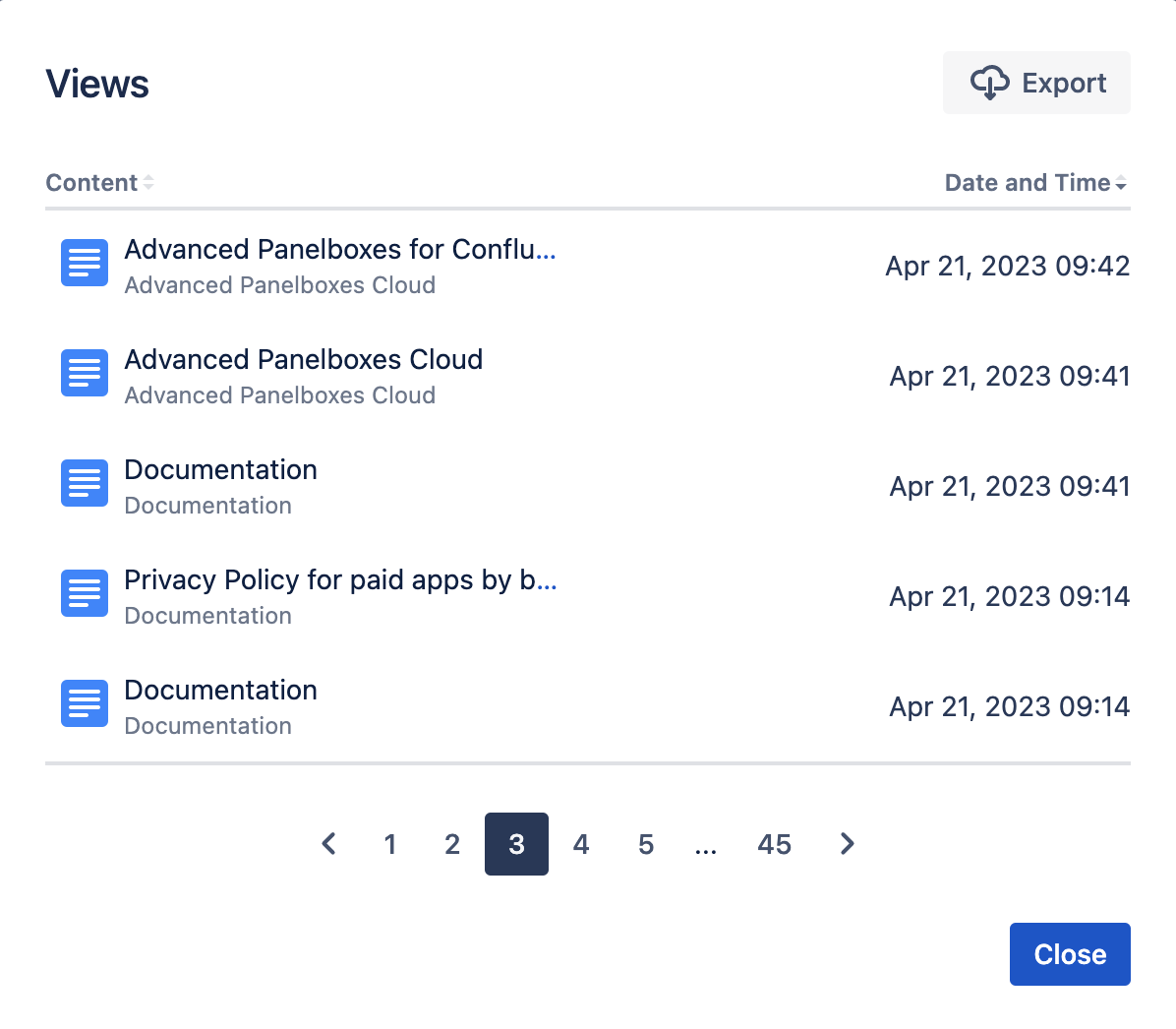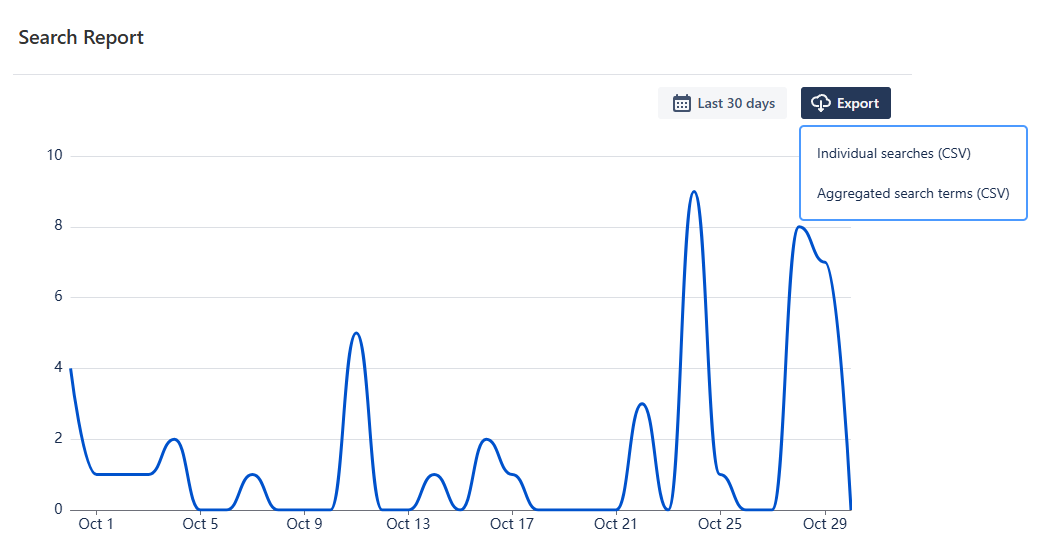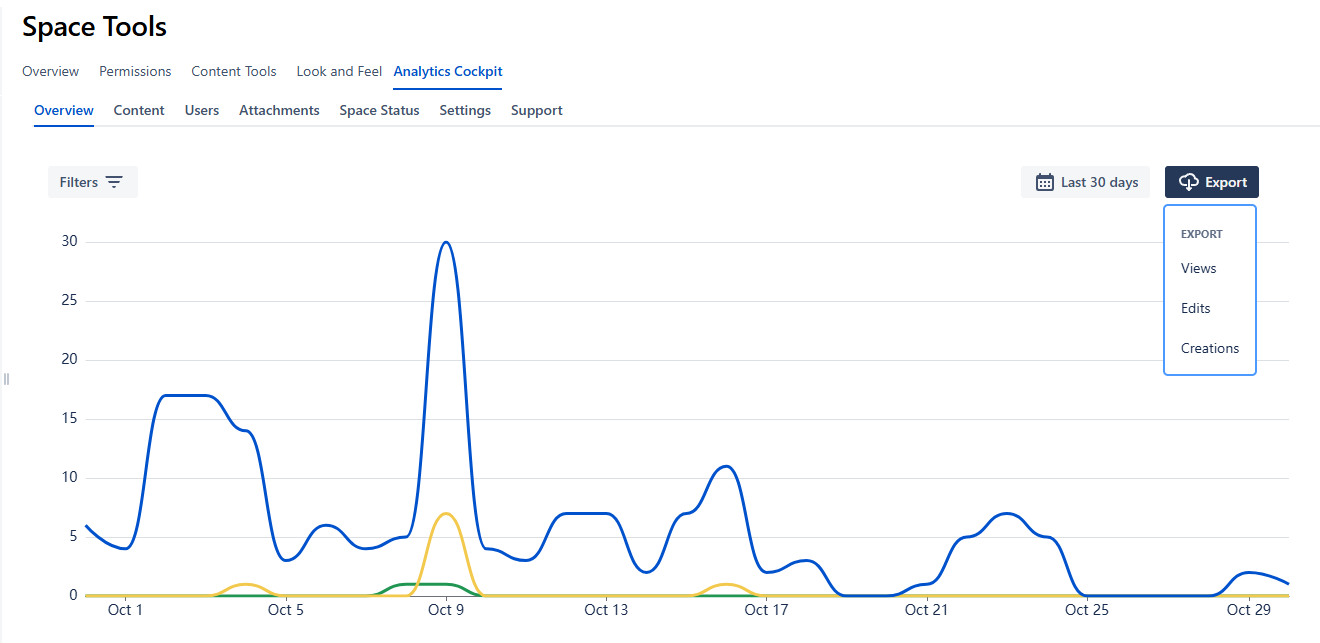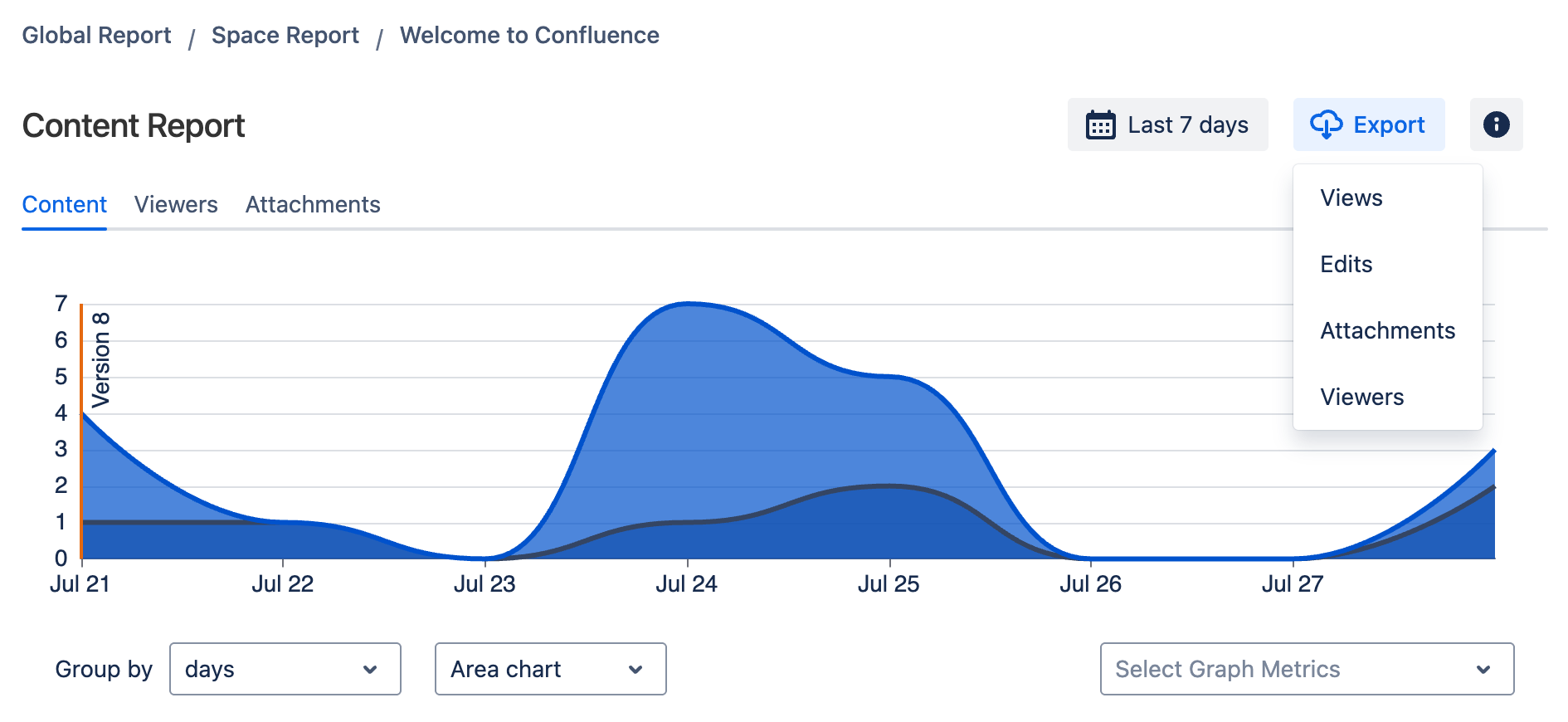📥 Export Viewtracker Data Center/Server Data
Overview
Viewtracker offers three methods to export collected data:
Built-in CSV export
REST API
SQL
Exports will follow Confluence's permission settings. Any content a user cannot access in Confluence will be marked as RESTRICTED in the export.
For instructions on exporting Viewtracker configuration information, please refer to: How to create a Viewtracker Support ZIP.
For details on importing data, please visit Import Data.
CSV Export
You can create a CSV file of the metrics from the current filter or selected date range in the built-in Viewtracker reports. The available metrics vary by report. Below, we list all the options for each report.
Global Report
You can export the Views, Edits and Creations via the “Export” option in the report menu.
Head to:
Analytics Cockpit → Global Content Report → Export → Views/Edits/Creations

Export options for the Global Report Overview
Content & Usage Report
Content & Usage Report: Spaces
All numbers in the export refer to the selected filter and date range (last 30 days by default).
You can export data from the Content Usage Report as a CSV file. Here’s how to export different items within this report:
Main table: Click the “Export” button next to the date range and confirm the amount of data.
All metrics summary: Click the “Export” button in the overlay.
Viewers: Click the “Export” button in the overlay.
Contributors: Click the “Export” button in the overlay.
Engaged users: Click the “Export” button in the overlay.

Export button present in the different reports
The CSV contains aggregated data from the report, including:
Main table: The CSV file contains the data fields you defined for the report in the report creation form.
“All metrics” summary: Number of spaces, Views, Views of trashed content, Total views, Viewers, Contributors, Engaged users, New content, Edits, Trashed content, Comments, Likes (on content), Likes (on comments), Watches.
“Viewers”: Viewer, Times Viewed, Last Viewed.
“Contributors”: Name, Times Contributed, Last Contributed.
Content & Usage Report: Content
All numbers in the export refer to the selected filter and date range (last 30 days by default).
You can export data from the Content Usage Report as a CSV file. Here’s how to export different items within this report:
Main table: Click the “Export” button next to the date range and confirm the amount of data.
All metrics summary: Click the “Export” button in the overlay.
Viewers: Click the “Export” button in the overlay.
Contributors: Click the “Export” button in the overlay.
Engaged users: Click the “Export” button in the overlay.
The CSV contains aggregated data from the report, including:
Main table: The CSV file contains the data fields you defined for the report in the report creation form.
All metrics summary: Number of content, Views, Views of trashed content, Total views, Viewers, Contributors, Engaged users, New content, Edits, Trashed content, Comments, Likes (on content), Likes (on comments), Watches.
Viewers: Viewer, Times Viewed, Last Viewed.
Contributors: Name, Times Contributed, Last Contributed.
Content & Usage Report: Users
All numbers in the export refer to the selected filter and date range (last 30 days by default).
You can export the report numbers as a CSV file.
Export the main table
Tap the “Export” button next to the date range.
Confirm the amount of data.
The CSV contains the aggregated data from the report, including the following:
Full Name, Views Total, Creates Total, Edits Total, Comments Total, Likes Total, Watches Total
Export the detailed user interactions (views, creations, edits, comments)
Tap the three dots in the “Views”, “Creations”, “Edits”, “Comments”, “Likes”, or “Watches” column next to a specific user.

Metrics available within the Content & Usage Report: Users
In the overlay, tap the “Export” button.

Example of the “Views” metric
Confirm the amount of data.
![]() The CSV contains the individual views, creations, edits, comments, likes and watches. It consists of "Content Title" and "Date and Time".
The CSV contains the individual views, creations, edits, comments, likes and watches. It consists of "Content Title" and "Date and Time".
Attachments Report
All metrics in the export correspond to the selected time filter and date range (default is the last 30 days).
To export the attachment report as a CSV file, follow these steps:
Go to Analytics Cockpit, select the "Attachments" entry, click Export, and choose either individual or aggregated views.

Screenshot highlighting export function
Individual views:
The exported CSV file will list each attachment view with details such as:
View ID, Attachment ID, Attachment Name, View Date, View UNIX Date, Username, Full Name, Content ID, Content Title, Content Type, Space Key, Space Name.
Aggregated views:
The exported CSV will summarize view events as shown in the Attachment Report, including:
Attachment Name, Space Name, Views, File Size (Bytes), Viewers
Search Report
All metrics in the export correspond to the selected time filter and date range (default is the last 30 days).
To export the Search report as a CSV, follow these steps:
Head to Analytics Cockpit, select the "Search" entry, click Export, and choose individual or aggregated views.

Export options for the Search Report
Individual searches:
This exported CSV file of the search report will include every single search event as follows:
Search ID, Search Term, Search Date, Search UNIX Date, Username, Fullname (if privacy setting allows it), Number of results
Aggregated search terms:
This exported CSV will include the aggregated searches and will include the following information:
Search Term, Number of Results, Number of Searches
Space Report
To export the Space report, head to:
Space Tools → Analytics Cockpit → Content → Export and choose between Views, Edits or Creations.

Export options for the Space Report
Exporting Views
This exported CSV file will contain the following categories:
Visit ID, Username, Full Name, Content Id, Content Title, Content Type, Source, Space Key, Space Name, Visit Date, UNIX Date
Exporting Edits
This CSV will contain:
ID, Username, Content Title, Content Type, Space Key, Space Name, Date, Unix Date
Exporting Creating
This last CSV will contain::
ID, Username, Content Title, Content Type, Space Key, Space Name, Date, Unix Date
Content Report
To export the Content Report, first access your desired page and click the Viewtracker icon (or access via the three dots “…“ and click Content Report).

Export Options for Content Report
Exporting Views
This exported CSV file will contain the following categories:
Visit ID, Username, Full Name, Content ID, Content Title, Content Type, Source, Space Key, Space Name, Visit Date, UNIX Date
Exporting Edits
The edits CSV will contain:
ID, Username, Content Title, Content Type, Space Key, Space Name, Date, Unix Date
Exporting Attachments
The CSV will list the metrics surrounding attachments in these categories:
View ID, Attachment ID, Attachment Name, View Date, View UNIX Date, Full Name
Exporting Viewers
This CSV will export the aggregated content views as displayed in the Viewers Tab and contains:
User ID, Username, Fullname, Content Title, Content Type, Space Key, Space Name, Viewer’s Name, Times Viewed, Last Viewed, Last Viewed Unix Date, Total Time Spent (if time tracking is enabled)
![]() Please note that the categories' Full Name” and “Username” can display values as “Anonymous” if Extended Privacy Mode is enabled.
Please note that the categories' Full Name” and “Username” can display values as “Anonymous” if Extended Privacy Mode is enabled.
API
An advanced option is the Viewtracker - REST Reporting API. This is especially interesting when integrating Viewtracker with other applications.
SQL
Utilize the table of tracked data inside the Confluence database via SQL.
To learn about the Viewtracker table, please refer to Viewtracker Data Structure.
